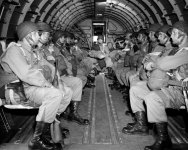I'd walk that statement back a little. True, there were 150,000 M1A1's made, but like Thompson SMG's, by 1944 their image appeal was suffering to the realities of combat and the need for weapons that could reach out and touch the enemy at combat ranges and still have power in the round to stop an enemy soldier. After combat in Sicily and Italy, the 82nd would likely have turned its weapons in for refit, and many of the M1A1's would receive new, wooden stocks during the refit. Glider riders of the 325th (82nd) and 327th (101st) as a rule, didn't receive Paratrooper accoutrements like M1942 jump suits or M1A1's, though some no doubt acquired them. The 504th did not jump as a regiment with the 82nd during the "Boston" missions of "Operation Neptune," as they were still recovering from their late return from Anzio. As was said earlier, its anybody's guess as to how many M1A1's were carried in by the 501st, 502nd, 505th, 506th, 507th or 508th's paratroopers, but they were probably limited to people like headquarters types, Radio operators, and the like.
A few other tidbits I've found in research: tying the aid pouch to the helmet netting seems to be predominantly a 101st thing, while arm sleeve flags are an 82nd thing. Additional pockets sewn to the sleeves: almost exclusively done in the 506th PIR, while the 505th (the only veteran PIR of the operation) mandated that every man jump an antitank mine in their combat load.
There are no absolutes I've found in my research and personal combat experience, but general rules of thumb... best to just roll with it. Andy's sculpts do a good job of representing US paratroopers of that era.


